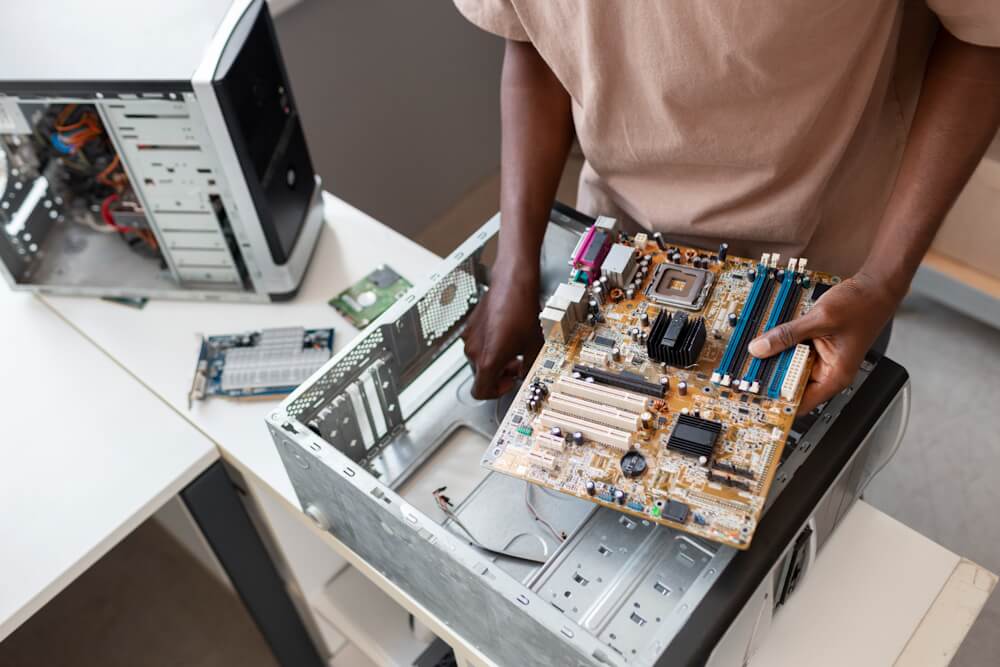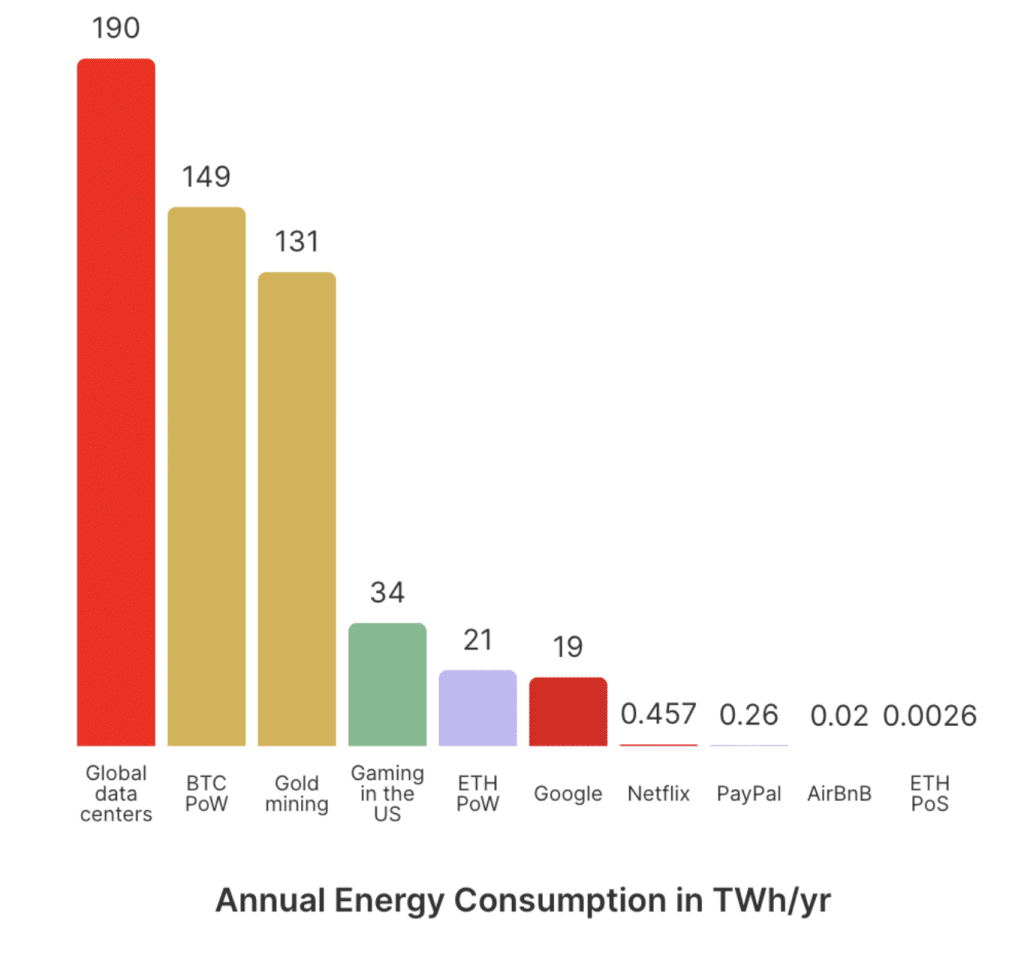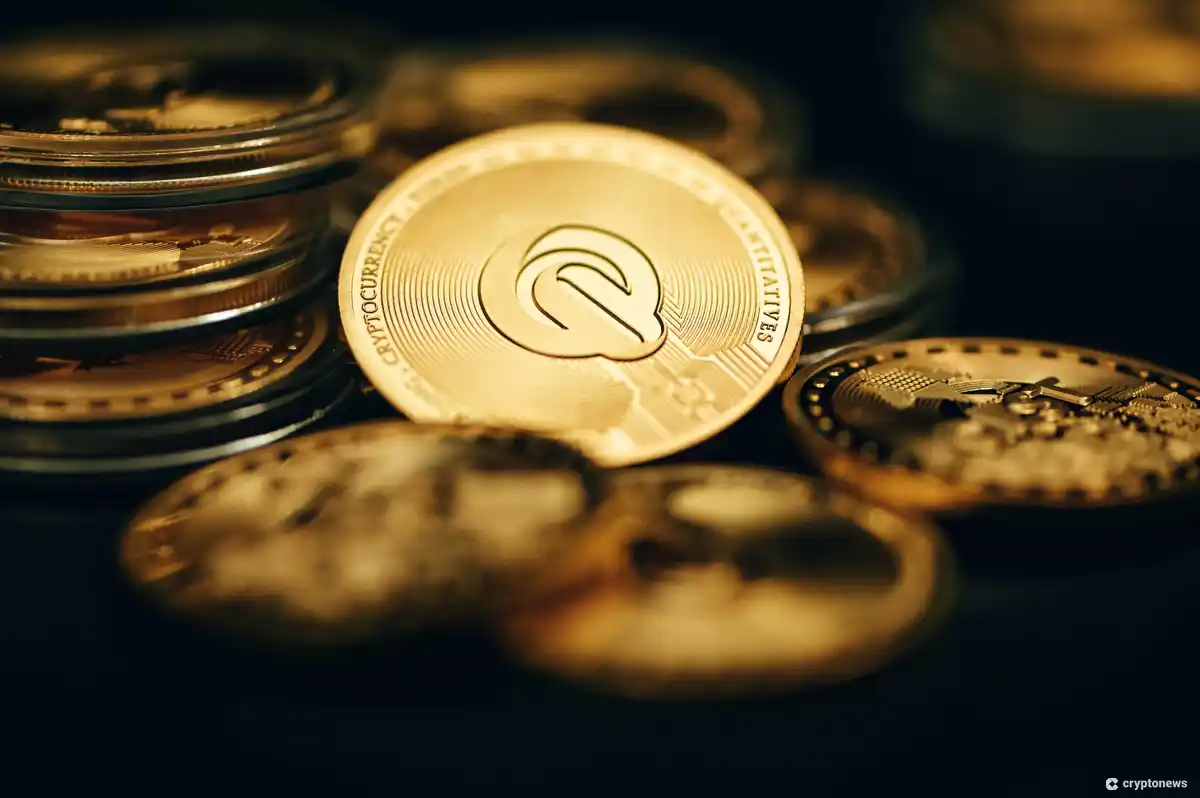What is Bitcoin Mining?

Bitcoin mining refers to the process of adding new blocks to the Bitcoin blockchain using a consensus mechanism called proof of work (PoW) that requires the entire network to agree on the validity of transactions.
Bitcoin miners around the world compete for the chance to add a new block and earn the block rewards paid in bitcoins. One recent block earned a 6.25 bitcoin mining reward plus 7.10 bitcoins in network fees. In this guide, we’ll explain how Bitcoin mining works as well as the pros and cons of mining Bitcoin.
How Does Bitcoin Mining Work?
Bitcoin mining gets its name from the work required to “find” (mine) a new block. Much like miners in the analog world have to expend energy to find gold, coal, or lithium, Bitcoin mining requires miners to expend energy to find a new block.
Each new block is a container for new transactions on the Bitcoin blockchain. Bitcoin mining uses proof of work (PoW) as its consensus (agreement) mechanism when adding new blocks to the blockchain. The expense of mining new blocks makes it impractical to change transactions that have already occurred.
Bitcoin’s mining process revolves around hashing, which is a cryptographic method to convert a value or set of data into another value. The Bitcoin network uses the SHA-256 (Secure Hash Algorithm – 256-bit) algorithm to accomplish this task.
The resulting hash is a 64-character hexadecimal (letters and numbers) value. Here’s an example of a hash using SHA-256 using the title of the Bitcoin white paper.
| Input | SHA-256 Hash |
| Bitcoin: A Peer-to-Peer Electronic Cash System | d1f40227cfca27d026d6e769833231242536e6b19df9b8374bef1ded606ca7cd |
The hashing function plays a vital role in mining Bitcoin, occurring at several steps along the way. If one letter or character of the input changes, the resulting hash changes dramatically.
Bitcoin Mining Overview
Here’s a brief overview of the mining process itself.
- Each block has a hash value. For example, the first block in the Bitcoin blockchain, called the Genesis Block, has the following hash: 000000000019d6689c085ae165831e934ff763ae46a2a6c172b3f1b60a8ce26f.
- The previous block’s hash links to the next block. The “chain” in blockchain comes from this linking of blocks using hash values. This hash value becomes part of a hashed block header used to solve the hash for the next block in the chain.
- Pending transactions in the mempool must also be hashed. As part of the formula, pending transactions stored in the network mempool (memory pool) are also hashed. If the miner successfully mines the next block, these transactions will be included in the block.
- Miners use a nonce to guess the qualifying hash value for the new block. A nonce is a number used only once. Miners try different numbers until the block hash has the required number of leading zeros to mine a new block. At Bitcoin’s beginning in 2009, the network generated thousands of hashes per second to guess the correct nonce. Now, the hash rate reaches quintillions of hashes per second across the worldwide network.
As the overall hash rate for the network ebbs and flows, the network also adjusts the difficulty for mining by changing the number of leading zeros required in a block hash.
Why does Bitcoin Need to Be Mined?
Mining, or proof of work more specifically, is what makes the Bitcoin network secure because the cost of mining makes it cost-prohibitive to change transactions. A rogue miner who wanted to change prior transactions would have to expend energy in mining while also mining faster than the rest of the network.
For example, if a rogue miner or mining group changed a single transaction in a prior block, that group would also have to re-mine every following block because the blocks are connected in order via hashes.
By design, the Bitcoin network chooses the fork of the chain with the most proof of work, so the rogue miner(s) would have to mine faster than the rest of the network (and without mining rewards) to make its alternative fork the main fork or the chain.
Mining allows Bitcoin to remain decentralized by using incentives and disincentives rather than intermediaries to maintain the ledger.
What is the Reward for Mining Bitcoin?
Currently, the mining reward for finding a new block provides two types of compensation. First, the winning miner earns a reward paid in newly minted bitcoins, currently 6.25 bitcoins per block. This is sometimes called the block subsidy.
Additionally, the winning miner earns the fees paid by network users for making transactions. This amount varies block by block. The comparison of the two reward components is known as the Bitcoin fee-to-reward ratio. Here’s an example using Bitcoin block 827023.
| Minted mining reward | 6.25 BTC |
| Network fees | 0.66922183 BTC |
| Total block reward | 6.91922183 BTC |
| Block reward in USD ($40,000/BTC) | $276,768.87 |
What Do You Need to Mine Bitcoin?
We’ve covered the basics of mining bitcoin, but what equipment do you need, and is mining a DIY endeavor?
In the early days. Bitcoin miners used CPUs to mine bitcoins, amassing massive stacks using machines less powerful than today’s smartphones. Fast forward, and the situation has changed. An increased hash rate on the Bitcoin network means increased difficulty. CPU mining isn’t practical anymore.
Today, you’ll need a computer equipped with one or more powerful graphics cards, also called graphics processing units or GPUs, but you are more likely to see some success using an application-specific integrated circuit (ASIC). These specialized chips excel at one task: Bitcoin mining, in this case. ASICs offer much higher hash rates while often using less power than GPUs.
Bitcoin Mining Hardware
A proper Bitcoin mining rig will need to use an ASIC to remain competitive. As far back as 2018, ASIC miners had taken over the industry, with a single ASIC capable of the same hash rate as 400 GPUs. While GPU mining is still possible, it’s more efficient when using a service that mines another cryptocurrency and then converts your mining rewards to bitcoins.

SHA-256 optimized ASICs cost from about $2,200 to nearly $9,000 on Bitmain, a popular mining equipment supplier. Higher-priced models typically offer much higher hash rates, better power efficiency, or both. Many newer ASICs use 25 Joules of energy or less per terahash (one trillion hashes).
Expect to invest several thousand dollars per machine to get started mining bitcoin directly. As an alternative, Bitcoin cloud mining provides a way to mine bitcoin without buying hardware, instead renting hash rate from providers who maintain the equipment.
Bitcoin Mining Software
Software for mining bitcoin ranges from free and open-source apps like CGMiner to software-as-a-service solutions like Hiveon, which charge a monthly fee per rig. These apps run on your local machine but can interface with mining pools, which we’ll cover next.
Mining Pools
Solo mining is possible. However, earning a reward for mining a block while mining on your own is extremely unlikely. Instead, you can consider contributing your hash power to a mining pool. These pools are just groups of miners working together. When the pool finds a block, the miners in the pool share the block reward proportionally, typically based on contributed hash power. Expect a small fee of 1% to 4% for using a pool.
How to Start Bitcoin Mining
The first step in mining bitcoin is to determine how much you’re willing to invest and whether you intend to mine as a hobby or as a business. As a hobby, your mining expenses aren’t tax deductible in many jurisdictions like the US. By contrast, as a business owner, you can make reasonable deductions for depreciation of equipment as well as electricity and software costs.
To help you make the decision, look for a bitcoin mining calculator that can estimate the amount you can earn based on your expected hash rate and electricity costs.
As a hobbyist or miner with one or two rigs, it may be more profitable to use a mining service that uses your hash power to mine another cryptocurrency and then convert your rewards to bitcoin. Under the hood, these services are mining pools, although the pool is likely mining something other than bitcoin, such as Ravencoin or another crypto.
Popular mining service options include:
- Unmineable
- Cudominer
- NiceHash
These solutions can be useful for bitcoin auto mining, using your computer to mine bitcoins or other cryptocurrencies when your computer is on and idle.
However, beware of Bitcoin mining scams. Research, read reviews, and use discernment before installing mining software on your computer.
Expect some inefficiency for legitimate mining services due to fees and conversion costs. Also, be aware that you’ll need to reach a minimum threshold to cash out your mining rewards.
How to Start Bitcoin Mining – Step-by-Step
For a walkthrough of a basic setup, let’s assume you want to mine to a pool using high-end GPUs or an ASIC.
Step 1: Build or Buy a Bitcoin Mining Rig
Research your options for a Bitcoin mining rig. The GPUs or ASIC you choose will do the heavy lifting, but you’ll also need a motherboard with a modern CPU and at least 8GB of DDR4 RAM.
For GPU pool mining, consider the following minimum specs:
CPU: Ivy Bridge or newer
GPU: Nvidia GTX 970, AMD Vega Frontier Edition, or similar graphics card
8GB DDR RAM or more
Many miners choose to invest in an ASIC to dramatically increase their hash rate.
Popular Bitcoin ASICs

- Canaan AvalonMiner 1246
- Bitmain Antminer S19 Pro
- MicroBT Whatsminer M30S++
- Bitmain Antminer T19
Before you buy a graphics card or ASIC, check compatibility with leading mining software like CGMiner. Many ASIC providers offer a bitcoin mining calculator that can help you evaluate the profitability and breakeven point for your purchase.
Also, consider your needs for a power supply. Additional cards or an ASIC require a more robust power supply.
Lastly, consider cooling. Bitcoin mining generates an enormous amount of heat. You’ll need a large case with adequate heat sinks and fans. Some miners build custom enclosures that allow maximum airflow.
Step 2: Set up a Bitcoin Wallet Address
When mining with a pool, the pool sends your mining rewards to your Bitcoin wallet address. Crypto wallets hold the private keys to control cryptocurrency and crypto assets on the network.
For mining, you may want to invest in a hardware wallet that works with a software wallet, the latter of which is usually free of charge but offers a more convenient way to access your funds. Hardware wallets act like two-factor authentication, requiring the user to approve transactions on a separate device.
Bitcoin Software Wallets
- Electrum
- Sparrow
- Bitcoin Core (for running a full node)
Bitcoin Hardware Wallets
Follow the instructions to set up a wallet address and securely store your seed phrase.
Step 3: Install Bitcoin Mining Software
Which mining software you install may depend on which pool you choose for mining.
For example, CGMiner is an open-source solution that allows you to optimize settings for your hardware. This free Bitcoin mining software lets you connect to your desired pool and port and add your wallet address.
Open-Source Bitcoin Mining Software
- CGMiner
- MultiMiner (GUI)
- BFGMiner
Commercial Bitcoin Mining Software
Paid apps offer additional management features, which can be handy if you’re running multiple mining rigs.
- Awesome Miner
- Hiveon App or HiveOS
Step 4: Choose a Bitcoin Mining Pool
Research the available pools and their supported reward types as well as fees. Generally speaking, Bitcoin mining pools pay rewards based on your contributed hash rate relative to the entire pool, splitting the rewards proportionally. However, there are some important nuances in structure to consider that can affect earnings.
Common Bitcoin Mining Reward Types
- PPLNS (Pay Per Last N Shares): This reward type is similar to pure proportional rewards. However, instead of the the number of shares in the round, instead looks at the last N shares, ignoring ends and beginning of rounds.
- PPS (Pay Per Share): Each successfully submitted share earns a fixed amount of BTC. Expect higher pool fees.
- FPPS (Full Pay Per Share): FPPS works similar to PPS, sharing a certain amount of the fixed block reward but also sharing some transaction fees.
Popular BTC Mining Pools and Configuration Instructions
Pool fees can reach up to 4%.
Step 5: Configure Your Bitcoin Software
Follow the instructions provided by the pool to successfully start mining.
Minimally, you’ll usually need the following:
- Mining algorithm (for miners that support multiple cryptocurrencies)
- Pool server address
- Port number (may be needed based on hash rate)
- Wallet address for payments
For example, CGMiner uses the following basic setup command:
- CGMiner -a [mining algorithm] -o [pool server] -u [username or wallet address]
Some pools, like BTC.com, require a signup process as well.
Step 6: Start Mining
Once you’ve configured your mining software, you’re ready to start mining. Check your mining software stats for errors or success messages. A misconfiguration can cause you to spend electricity on mining without earning anything. You can also check the dashboard on most pools to see your contributed hash rate and expected earnings.
Keep records of earnings and the value of your rewards at the time you earned them. For tax purposes, mining rewards are taxable in jurisdictions like the US, with the value of the rewards in USD becoming your cost basis for future capital gains (or capital losses) calculations.
Bitcoin Mining Pros and Cons
Carefully weigh the pros and cons of Bitcoin mining before making a decision to invest in hardware.
Pros
- Helps support the security of the Bitcoin network
- Promotes decentralization
- Can generate a long-term profit
- Provides an additional income stream
Cons
- Volatility and market risk
- Electricity and hardware costs
- Can create a tax liability that may force a sale of BTC
- Noisy and creates heat
How does Bitcoin Cloud Mining Work?
Cloud mining follows the same pattern as other cloud computing or cloud storage solutions: you’re using someone else’s computer. Cloud mining platforms provide and maintain the hardware and you lease computing power for a fee.
Two popular models include hosted mining and leased hash power.
Hosted mining: With hosted mining, you lease an entire mining rig from a provider, typically a mining farm. The provider owns and maintains the equipment.
Leased hash power: When using leased hash power, you’re sharing the hash power of a rig or multiple rigs run by a remote provider. The hash power comes from whichever machine has spare capacity.
Bitcoin cloud mining offers several advantages compared to mining with your own equipment, particularly in administrative areas; someone else sets up and maintains the mining rigs. Someone else also makes the hardware investment.
However, the disadvantages can include cost. You’ll pay for the service, which can eat into your mining earnings or even cause a loss. Another potential issue involves Bitcoin mining scams. Cloud mining companies can disappear without notice.
How Does Bitcoin Mining Affect the Price of Bitcoin?
The effect of mining on BTC’s price is likely minimal, with the exception of two key market forces that push in opposite directions.
- A strong mining network helps to support price. A decentralized mining community makes Bitcoin an attractive store of value and medium of exchange.
- Miners also create selling pressure. To cover hardware, administrative, and electricity costs, miners sell BTC, which can affect the price.
However, a larger consideration is the price of bitcoin relative to mining costs. If BTC falls in value, a profitable miner can quickly become unprofitable. When prices dip, miners may have to hold their BTC and finance mining through reserves or even loans until prices recover enough to sell profitably. The alternative is to sell at a loss.
Risks Associated with Bitcoin Mining
Bitcoin mining brings advantages, including decentralization for the network and the ability for miners to earn a profit. However, mining also brings risks, some of which affect the miners themselves and some of which may be a concern for everyone.
High Electricity Use
Estimates from the Rocky Mountain Institute indicate that the energy use from Bitcoin mining worldwide reaches 127 terawatt-hours (TWh) annually, which is more than some countries. However, it’s also helpful to put numbers in context. Separate estimates put the banking industry’s energy consumption at 56 times that of Bitcoin.
At an individual miner level, electricity costs remain an ongoing expense for mining rigs. Many mining companies have relocated miners to areas where energy is cheaper or trapped, meaning the energy can’t easily be transported and might be wasted without mining utilization.
Potential Damage to GPU
Heat remains likely the most damaging aspect of mining for individual miners. GPUs and motherboards are particularly susceptible to heat damage, which can lead to throttling (slowed operation) or hardware failure. Expect lower life spans and more frequent component replacement for equipment than you could reasonably expect with casual use.
Environmental Impact
Bitcoin mining may be responsible for warming more than your server room. A recent paper published in Cell Press suggests that Bitcoin mining may be contributing as much as 0.2% of the world’s greenhouse gas emissions.
Before converting from proof-of-work to proof-of-stake consensus, Ethereum mining consumed 21 TWh/yr, more than Google’s energy usage worldwide.

After converting to proof of stake, Ethereum is estimated to use just 0.0026 TWh/yr, a minuscule fraction of the energy the blockchain once used.
Raw numbers only tell part of the story, however. More than half of Bitcoin mining uses sustainable energy.
Bitcoin is unlikely to convert to proof of stake in the near future. Miners should consider how supporting the network could impact the environment.
Bitcoin Mining Scams
The cloud mining industry, as convenient as it appears, is also fraught with peril in many cases. Many Bitcoin mining scams center on service providers that offer to mine Bitcoin for you on their servers. In many cases, fees may not be well disclosed, or potential returns may be greatly exaggerated. In some situations, the service provider may not exist at all or might disappear suddenly.
In 2016, HashOcean, a cloud mining company, vanished overnight. More than 700,000 users worldwide reportedly suffered losses.
Is Bitcoin Mining Legal?
Bitcoin mining is legal in most parts of the world, including the US and the UK. However, local jurisdictions may place restrictions on energy usage or govern property usage through zoning, which may require choosing a different location. Be sure to check with your local municipality, state, or regional offices.
Do I Have to Pay Taxes on the Bitcoin I Mine?
Expect to pay taxes on mined bitcoins in most jurisdictions. However, rules may vary depending on where you live.
For example, in the US, Bitcoin mining rewards are taxable as follows.
- Mining rewards are taxable as income at the time they are received.
- The value in USD at the time of receipt becomes the cost basis for calculating capital gains or losses.
- Capital gains taxes may apply if you realize a profit relative to your cost basis when you sell or otherwise dispose of your bitcoins.
- Mining equipment and electricity costs are not deductible expenses for hobbyists. Mining businesses (sole proprietors) can make appropriate deductions on Schedule C. However, note that equipment may need to be depreciated rather than expensed all at once, depending on your tax circumstances.
Is Bitcoin Mining Worth It for Me?
If you’re considering mining bitcoin, it may be wisest to take a long-term approach, which allows you to weather the market’s ups and downs. To do this, however, you’ll likely need to work from a well-capitalized position. In other words, don’t mine if you need the money to pay the monthly bills.
Many miners who have been able to hold some or all of their mined bitcoin have done extremely well, with some sitting on staggering gains. Expect to make a sizable investment in equipment, though, some of which you may need to replace or update to continue mining profitably. By design, mining remains a cost-intensive endeavor. But for risk-takers with a long-term outlook, Bitcoin mining can prove quite lucrative while also supporting the Bitcoin network.
References
- Bitcoin: A Peer-to-Peer Electronic Cash System (Bitcoin.org)
- Blockchain Explorer (Blockchain.com)
- What Is Bitcoin’s Fee-To-Reward Ratio? (Binance.com)
- Non-specialized hardware comparison (Bitcoin.it)
- Mining Bitcoin with a GPU (Thegeekpub.com)
- Bitcoin Miners Buy Up Rigs as Prices Near All-Time Lows (Coindesk.com)
- Depreciation & Recapture (IRS.gov)
- Miners Settings & Fees (Antpool Support)
- How to mine Bitcoin
- Bitcoin mining tutorial (BTC.com)
- CGMiner Setup Guide (CGMiner.info)
- Cryptocurrency’s Energy Consumption Problem (Rocky Mountain Institute)
- Why banking uses at least 56x more energy than Bitcoin (Cointelegraph.com)
- Revisiting Bitcoin’s carbon footprint (Cell.com)
- Ethereum’s energy expenditure (Ethereum.org)
- HashOcean Scam Victims Sign Petitions to FBI, Hackers to Reveal More Scams (Cointelegraph.com)
- Digital Assets (IRS.gov)
- Frequently Asked Questions on Virtual Currency Transactions (IRS.gov)
- Sales and Other Dispositions of Assets (IRS.gov)
- Hobby or Business? IRS Offers Tips to Decide (IRS.gov)
- Instructions for Schedule C (IRS.gov)
FAQs about Mining Bitcoin
What is mining bitcoin?
Bitcoin mining describes the process of finding a new block to hold transactions on the blockchain.
How does mining bitcoin work?
Bitcoin miners use computing power to generate random numbers until they find a number for which the hash value of the block header, hashed transactions, and the number itself (called a nonce) have a qualifying number of leading zeros. The first miner to find a qualifying nonce builds the next block in the blockchain and earns the block rewards.
How do I start mining bitcoin?
A service like Unmineable or Cudominer provides the easiest way to earn bitcoin through mining, although these services typically mine another cryptocurrency and exchange it for bitcoin. Alternatively, you can start mining with a current computer and a capable graphics card by contributing your computing power to a mining pool.
How much can you make mining bitcoin?
Many miners who mine at home earn about $30 up to $500 monthly. If you’re able to hold your mined bitcoin until the market rises, earnings can reach much higher.
How much electricity does Bitcoin mining use per day?
A single mining rig running with three graphics cards can use more than 20,000 watts of power daily.
How much does a Bitcoin mining rig cost?
Bitcoin mining rigs can cost a few thousand dollars up to ten thousand dollars or more. GPU-powered miners offer a lower price tag, but ASIC-powered miners provide more efficient mining. Popular ASICs range in price from $2,000 up to $6,000. After the cost of building the rest of the rig, including the motherboard, CPU, cooling, and RAM, an ASIC-powered rig can cost up to $10,000.
How can I start Bitcoin mining for free?
If you already own a capable gaming computer, you may be able to mine bitcoin using CGMiner or similar open-source mining software. Ongoing costs include electricity to run the miner as well as wear and tear on your hardware. The heat from constant mining can damage computer components over time.
Are Bitcoin mining and Bitcoin cloud mining the same?
No. Bitcoin mining typically refers to mining on hardware you own and control. Cloud mining, on the other hand, refers to using a miner owned and maintained by a remote provider. While some cloud mining providers offer a legitimate service, the industry is plagued by scams and providers who do not disclose profits or costs accurately.
Disclaimer: Crypto is a high-risk asset class. This article is provided for informational purposes and does not constitute investment advice. You could lose all of your capital.
About Cryptonews
At Cryptonews, we aim to provide a comprehensive and objective perspective on the cryptocurrency market, empowering our readers to make informed decisions in this ever-evolving landscape.
Our editorial team, comprised of more than 20 professionals in the crypto space, works diligently to uphold the highest standards of journalism and ethics. We follow strict editorial guidelines to ensure the integrity and credibility of our content.
Whether you’re seeking breaking news, expert opinions, educational resources, or market insights, Cryptonews.com is your go-to destination for all things crypto since 2017.


 Kane Pepi
Kane Pepi 


 Michael Graw
Michael Graw